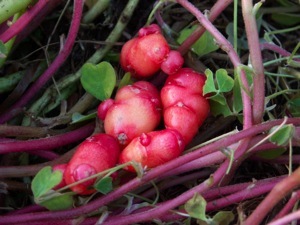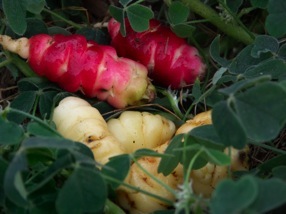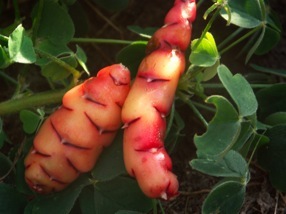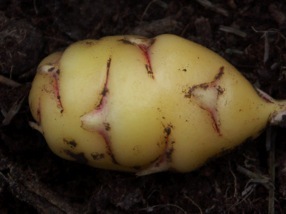
Oca
Oca (oxalis tuberosa) is a tuber that deserves a more widespread attention. For thousands of years this has been a major food in the Andean parts of South America, where there are many varieties. It can be grown over here, even quite easily if you take some precautions. The plants are almost exclusively propagated by tubers, although it is possible to sow them, but this is very unusual.(For more on this last method, I’ll make a page on a project trying to reduce the daylength-sensibility, but that’s for later)
The tubers are planted out in little pots in the greenhouse from the end of March. You can use tubers from 3-4 cms to plant, if conditions are good, they will eventually produce full-size tubers up to 8-9 cms or even more. Give them a moderate heat (20 -25°Celsius works fine) and keep them moist. Shoots will appear within two weeks or even quicker. These shoots are frost tender, so keep them away from very low temperatures. Plant the ocas in open air whenever the risk of frost has gone. They like full sun to semi-shade, plant them preferably in a spot where there is little chance of an early frost in autumn. They are very adaptable to any kind of soil, I don’t have the experience that heavy fertilisation enlarges the harvest. Space them 30x50 cms, 50 in the rows. Ocas will produce more if they are upearthed, the way potatoes are upearthed. You can do this until mid-september.
As so many Andean plants, ocas are daylength-sensitive. So they will only start to form tubers after September 21. Due to the fact the stalks are frost tender, early frost can mean a near to zero harvest. On the contrary, a very late frost (for example by the end of November) insures a good harvest of tubers. If there is an announcement of an early frost (September-october), you can always cover them up with plastic ,old blankets,…
Ocas don’t really grow well in greenhouse circumstances. Although they seem to tolerate more heat and drought than Ullucus, they don’t become as big and productive as they will be outside (stems can be about 80-100 cms long).
Harvest is done as late as possible, I always try to keep the plants frost-free until the end of November or later. This insures a good harvest of full-size tubers. Harvest the tubers the way potatoes are harvested, clean them up , let them dry for a few days (frost-free!) and store them the way potatoes are stored. Recipes for ocas are similar to recipes for potatoes: baking, boiling,…They have a more acidic taste than potatoes, but this taste can become sweeter if you leave the tubers for a few weeks in the sun. In the Andes (more sun ) this takes a few days (some varieties become so sweet that they are eaten as a dessert), in our short winter days this takes up a few weeks or even more.
Some other things are edible as well, leaves can be added to salads, but don’t eat too much of these, they contain toxic elements. Youngs stems can be boiled or steamed and served with a bit of butter (they’re very nice in combination with apples).
There’s another way to propagate ocas, and that’s by taking cuttings. These cuttings root up quickly, without any problem, and it’s a way to have a bigger harvest from this rare oca variety you obtained from a friend . Start the tubers as described above, wait until the shoots are about 15 cms long, and carefully break these off from the tubers and replant them in some potting earth, keep them out of intense sun for at least 8 days, and water regularly. The cuttings will soon grow out to reasonably sized plants (although they won’t become as big as the mother plants) and give you a fair harvest in autumn. This is also a good way to select on peculiar colours, break off the shoot where this colour is present, and grow it on (don’t forget to label it!).








